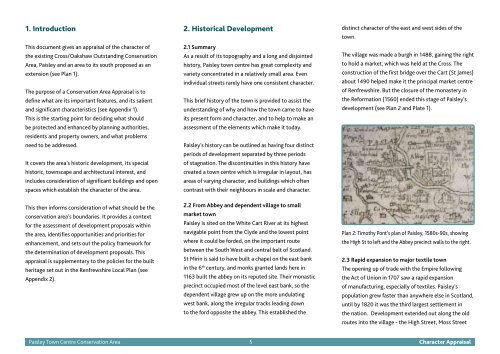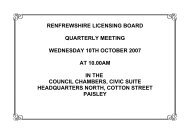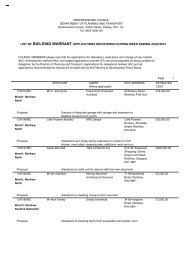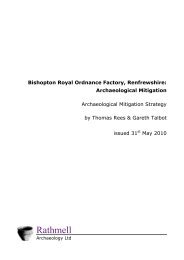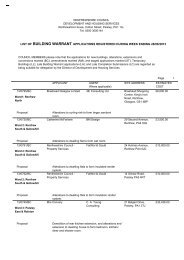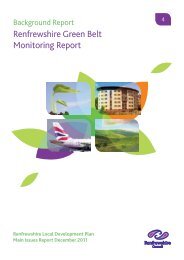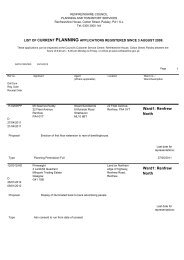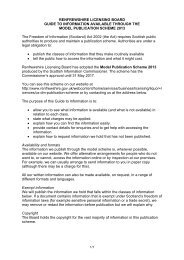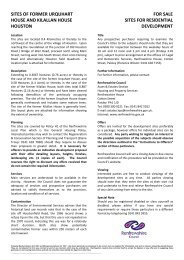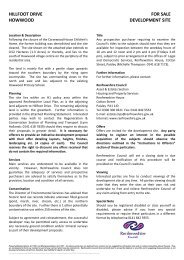Paisley Town Centre Conservation Area Character Appraisal
Paisley Town Centre Conservation Area Character Appraisal
Paisley Town Centre Conservation Area Character Appraisal
You also want an ePaper? Increase the reach of your titles
YUMPU automatically turns print PDFs into web optimized ePapers that Google loves.
1. Introduction<br />
This document gives an appraisal of the character of<br />
the existing Cross/Oakshaw Outstanding <strong>Conservation</strong><br />
<strong>Area</strong>, <strong>Paisley</strong> and an area to its south proposed as an<br />
extension (see Plan 1).<br />
The purpose of a <strong>Conservation</strong> <strong>Area</strong> <strong>Appraisal</strong> is to<br />
define what are its important features, and its salient<br />
and significant characteristics (see Appendix 1).<br />
This is the starting point for deciding what should<br />
be protected and enhanced by planning authorities,<br />
residents and property owners, and what problems<br />
need to be addressed.<br />
It covers the area’s historic development, its special<br />
historic, townscape and architectural interest, and<br />
includes consideration of significant buildings and open<br />
spaces which establish the character of the area.<br />
This then informs consideration of what should be the<br />
conservation area’s boundaries. It provides a context<br />
for the assessment of development proposals within<br />
the area, identifies opportunities and priorities for<br />
enhancement, and sets out the policy framework for<br />
the determination of development proposals. This<br />
appraisal is supplementary to the policies for the built<br />
heritage set out in the Renfrewshire Local Plan (see<br />
Appendix 2).<br />
2. Historical Development<br />
2.1 Summary<br />
As a result of its topography and a long and disjointed<br />
history, <strong>Paisley</strong> town centre has great complexity and<br />
variety concentrated in a relatively small area. Even<br />
individual streets rarely have one consistent character.<br />
This brief history of the town is provided to assist the<br />
understanding of why and how the town came to have<br />
its present form and character, and to help to make an<br />
assessment of the elements which make it today.<br />
<strong>Paisley</strong>’s history can be outlined as having four distinct<br />
periods of development separated by three periods<br />
of stagnation. The discontinuities in this history have<br />
created a town centre which is irregular in layout, has<br />
areas of varying character, and buildings which often<br />
contrast with their neighbours in scale and character.<br />
2.2 From Abbey and dependent village to small<br />
market town<br />
<strong>Paisley</strong> is sited on the White Cart River at its highest<br />
navigable point from the Clyde and the lowest point<br />
where it could be forded, on the important route<br />
between the South West and central belt of Scotland.<br />
St Mirin is said to have built a chapel on the east bank<br />
in the 6 th century, and monks granted lands here in<br />
1163 built the abbey on its reputed site. Their monastic<br />
precinct occupied most of the level east bank, so the<br />
dependent village grew up on the more undulating<br />
west bank, along the irregular tracks leading down<br />
to the ford opposite the abbey. This established the<br />
distinct character of the east and west sides of the<br />
town.<br />
The village was made a burgh in 1488, gaining the right<br />
to hold a market, which was held at the Cross. The<br />
construction of the first bridge over the Cart (St James)<br />
about 1490 helped make it the principal market centre<br />
of Renfrewshire. But the closure of the monastery in<br />
the Reformation (1560) ended this stage of <strong>Paisley</strong>’s<br />
development (see Plan 2 and Plate 1).<br />
Plan 2: Timothy Pont’s plan of <strong>Paisley</strong>, 1580s-90s, showing<br />
the High St to left and the Abbey precinct walls to the right.<br />
2.3 Rapid expansion to major textile town<br />
The opening up of trade with the Empire following<br />
the Act of Union in 1707 saw a rapid expansion<br />
of manufacturing, especially of textiles. <strong>Paisley</strong>’s<br />
population grew faster than anywhere else in Scotland,<br />
until by 1820 it was the third largest settlement in<br />
the nation. Development extended out along the old<br />
routes into the village - the High Street, Moss Street<br />
<strong>Paisley</strong> <strong>Town</strong> <strong>Centre</strong> <strong>Conservation</strong> <strong>Area</strong> 5 <strong>Character</strong> <strong>Appraisal</strong>


